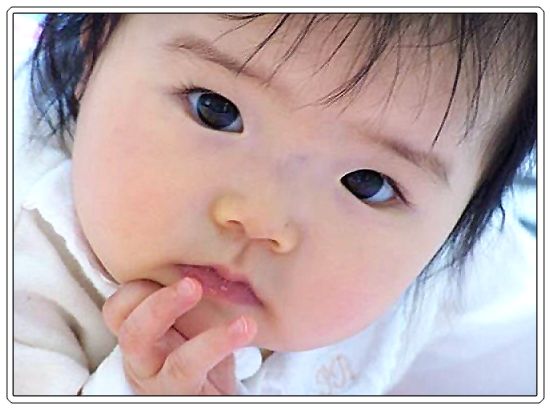
On the left: image of the supermodel Kate Moss, on the right: example of a photographed 4-year-old girl that took part in our experiment regarding the "babyfaceness hypothesis". The face of Kate Moss clearly shows characteristic features of babyfaces, but at the same time it also includes mature female features like high, prominent cheek bones and concave cheeks which are accentuated evenly by using make-up. Cunningham (1986) claims that the presence of both characteristic features makes faces very attractive.
Research on facial attractiveness has pointed out that the presence of childlike facial features increases attractiveness. These are:
- Large head
- Large curved forehead
- Facial elements (eyes, nose, mouth) located relatively low
- Large, round eyes
- Small, short nose
- Round cheeks
- Small chin
The prototype for a "child woman" is Brigitte Bardot. The reason why childlike women are perceived as being more attractive, is a biological one: Evolutionary biologists argue that men have an reproductive advantage when preferring young women as mating partners since they are likely to be healthy and still having a long period of fertility ahead of them. Thus, he can have many children with young women which means that he can successfully pass on his genes to his descendants.
However, this idea is more than debatable. But why? Well, we mentioned above that characteristics of mature females contribute to facial attractiveness, too. These are, for instance, high and pronounced cheekbones and concave cheeks (note: this is the opposite of the childlike, round cheeks!). The biological reason for this is that these characteristics signal the man to have found a sexually mature and fertile woman. Some researchers on attractiveness (e.g. Karl Grammer) are convinced that childlike facial characteristics just make female faces look younger, but not more attractive.
In order to examine the so-called "babyfaceness hypothesis", we produced several variants of selected female faces. The variants all had different levels of childlike facial proportions and were judged for attractiveness by test subjects.
| On the left: four children aged of 4 to 6.5 years; on the right: derived scheme of childlike characteristics. | ||||
This is how we went about: we computed an "average child face" using the four original images. Subsequently, we selected several attractive woman faces. By using the morphing technique we gradually warped the facial shape of the female faces into the shape of the scheme of childlike characteristics. Only the proportions of the faces were manipulated, not the faces itself! http://www.uni-regensburg.de/Fakultaeten/phil_Fak_II/Psychologie/Psy_II/beautycheck/english/kindchenschema/kindchenschema.htm |







No comments:
Post a Comment